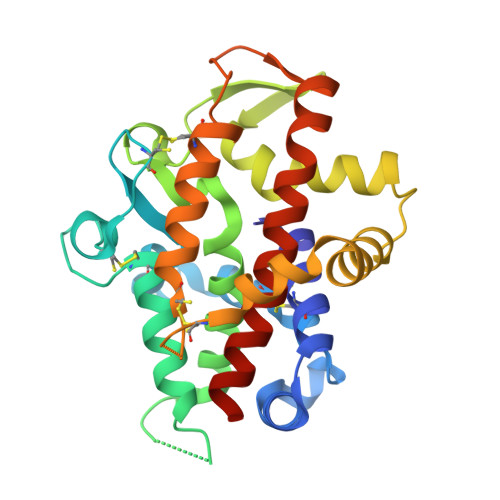Structural Insights of the Ssdna Binding Site in the Multifunctional Endonuclease Atbfn2 from Arabidopsis Thaliana.
Yu, T., Maestre-Reyna, M., Ko, C., Ko, T., Sun, Y., Lin, T., Shaw, J., Wang, A.H.(2014) PLoS One 9: 05821
- PubMed: 25157844
- DOI: https://doi.org/10.1371/journal.pone.0105821
- Primary Citation of Related Structures:
4CWM, 4CXO, 4CXP, 4CXV - PubMed Abstract:
The multi S1/P1 nuclease AtBFN2 (EC 3.1.30.1) encoded by the Arabidopsis thaliana At1g68290 gene is a glycoprotein that digests RNA, ssDNA, and dsDNA. AtBFN2 depends on three zinc ions for cleaving DNA and RNA at 3'-OH to yield 5'-nucleotides. In addition, AtBFN2's enzymatic activity is strongly glycan dependent. Plant Zn(2+)-dependent endonucleases present a unique fold, and belong to the Phospholipase C (PLC)/P1 nuclease superfamily. In this work, we present the first complete, ligand-free, AtBFN2 crystal structure, along with sulfate, phosphate and ssDNA co-crystal structures. With these, we were able to provide better insight into the glycan structure and possible enzymatic mechanism. In comparison with other nucleases, the AtBFN2/ligand-free and AtBFN2/PO4 models suggest a similar, previously proposed, catalytic mechanism. Our data also confirm that the phosphate and vanadate can inhibit the enzyme activity by occupying the active site. More importantly, the AtBFN2/A5T structure reveals a novel and conserved secondary binding site, which seems to be important for plant Zn(2+)-dependent endonucleases. Based on these findings, we propose a rational ssDNA binding model, in which the ssDNA wraps itself around the protein and the attached surface glycan, in turn, reinforces the binding complex.
Organizational Affiliation:
Institute of Bioinformatics and Structural Biology, National Tsing Hua University, Hsinchu, Taiwan; Institute of Biological Chemistry, Academia Sinica, Taipei, Taiwan.




















